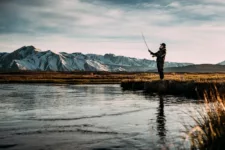A fishfinder is a device that detects reflected sound energy used to discover fish in the water. Through a graphical display of the detected pulse of sound energy, an operator can understand what is happening in a location underwater and locate fish or sunken debris. It is used mostly by commercial fishermen and for sports.
Fishfinders are of two types–the down imaging and side imaging fishfinders. The down imaging, as the name suggests, scans directly beneath the ship while the side imaging fish finders scan the sides of the boat. Side imaging finders can cover a distance of 240 feet and also give the user a graphical picture of the scanned areas. The fishfinder to use depends on the type of fishing you want to engage in and the one most convenient for you.
Sound Navigation and Ranging (Sonar) is a form of an underwater radar system that sends out beams of sound energy and discovers items such as vessels, fish, or any item under the water surface. Sonar is of two types–the active and the passive sonar.
Active sonar uses a sound transmitter and a receiver which may be monostatic (when both the transmitter and sound are in one location) or bistatic (when both are in separate locations). It is used to listen to echoes and for measuring the distance from the transducer to the bottom of the water. When it performs such duty, it is called echo sounding. Passive Sonar listens to sounds made by vessels. It is used in military service and in scientific operations. It can be used to determine the presence or absence of fish in the water.
A fishfinder uses passive sonar optimised for a better fishing experience. Unlike the fishfinder, sonar sometimes affects the fish’s hearing because of the sound it emits. These and more are where the fishfinder gets an edge over sonar.
Similarities
Considering that the fishfinder is used to detect reflected sound energy just as sonar, both are nearly the same.
∙ They are used to locate fish in water.
∙ They use reflected sound energy to detect fish.
Differences
∙ The fishfinder is specifically designed to find fish while the sonar performs other functions besides finding fish like locating a vessel, calculating the distance from a location underwater or from the seabed, amongst others.
∙ A fishfinder can only search in one direction (some models can cover larger angles especially in side imaging) vertically beneath or by the side of the vessel, while a sonar can look in every direction.
∙ The sound emitted by sonar is sometimes harmful to fish (when it is of high frequencies) while fishfinders have no negative effect on fish.
Factors to Consider When Selecting a Fish Finder
A fishfinder helps you save time and makes your fishing experience more effective. Some fishfinders have features like a GPS tracker, a compass to determine direction, and marine radar. These features not only help you find fish but also track your location.
When buying a fishfinder, quality and compatibility matter a lot. If you focus on the prices, you may end up with one that will not offer value for the money spent on it. Fish Finders NZ gives you fishfinder options for little cost and greater value. The following are factors you should before choosing a fishfinder.
∙ Screen Size
The average fishfinder screen ranges from 3.5″ to 6″–the bigger the screen, the better the service. A larger screen helps you to see the information gathered by the fishfinder. Check the pixels because sometimes as the screen size increases the quality of the image decreases. Check other features and ensure you do not sacrifice other essential features for screen size.
∙ Portable or Fixed?
Fishfinders are attached permanently to many big fishing boats. Affixed fishfinders are high-tech, will augment your hull, and also accelerate the level of your fishing game. If the fishing boat is yours, go for an affixed fishfinder. Portable fishfinders are suitable for rented boats. They are lightweight and easy to transport. How often you fish also should determine if you need a portable or a fixed fishfinder. If you fish occasionally, opt for a portable fishfinder. But if you fish for commercial purposes, go for an affixed fishfinder.
∙ GPS Integration
GPS and fishfinding detection are one of the essential qualities of a good fishfinder. GPS is important especially for kayak and boat fishing. You may go for a fishfinder without GPS if you are into pier or shoreline fishing.
∙ Glare Protection
The fishfinder screen may be hard to read in bright sunny weather. To correct this, you can purchase a shade visor or move the fishfinder to a less sunny part of the ship. Though some LCD films cut glare when used, there is also an option to dim the screen’s brilliance and contrast. Recent fishfinders come with glare resistant screens for a better viewing experience.
∙ Low-light Fishing
You could go for a back-lit screen fishfinder if you prefer to fish early morning, during winter, or at dusk.
Fishing in New Zealand is a pleasant experience that requires the best service or tools to enhance it. Using a fishfinder instead of just sonar technology makes you better at fishing and gives varied options.
Image Source: Unsplash.com








